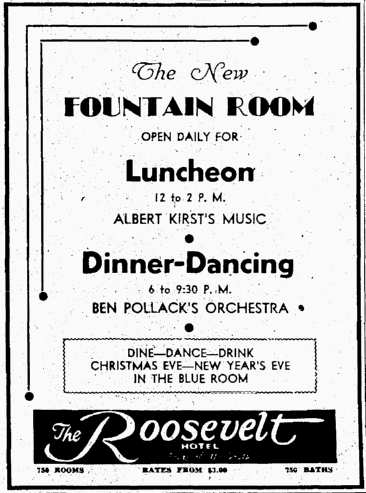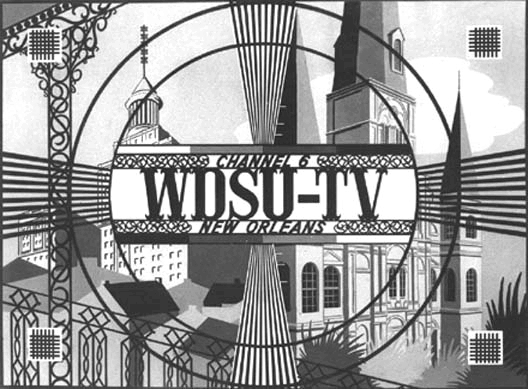|
Today in New Orleans History |
|
|
December 18


Roosevelt
Hotel Fountain Room This advertisement
appeared in the December 18, 1935 edition of the Times-Picayune. Patrons were invited to lunch to the
tunes of Albert Kirst or dine and dance to Ben Pollack's Orchestra at the new Fountain Room a the Roosevelt
Hotel.
|
||
|
Jazz and Blues singert Louise "Blue Lu" Dupont Barker, famous for "Don't You
Feel My Leg" and "Look What Baby's Got For You" was born in New Orleans on November 13, 1913. She often sang
and performed with her husband Danny Barker. Her recording of "A Little Bird Told Me" was released by Capitol
Records and reached the Billboard chart on December 18, 1948 and remained on the chart for 14, peaking at
#4. Blue Lu was inducted into the Louisiana Blues Hall of Fame in 1997, one year before she died in her home town on May 7,
1998 at the age of 84. The defense was that the
case came under the Workmen's Compensation Act, but Judge King held that the Legislature had no power to deprive a person,
permanently injured, of the right to sue for damages sustained. If the act did this, the poor woman would get a mere pittance.
After studying the act, it was clear to his mind that the measure was intended for the benefit of the working men and women,
but if he put upon it the construction defendants contended for, it was an injury to both, because it deprived them of a
legal right. Besides that, under the compensation act itself, it was the duty of the defendant to
inform this woman when she entered employment, of the compensation act, and to get her to say whether she accepted employment
under this act, or stood under the general law. This woman is young, said Judge King, under thirty years of age, and is disfigured
for life. She is deprived of the chances of marriage, and of working with other persons without comment. He knew of only
one other case as painful, and that was where an employe of the railways company was caught in electric wires and cremated
before the eyes of his wife and children. He was firmly convinced a judgment of $10,000 should be given." From
the New Orleans Public Library WDSU Television Goes on the Air The radio station
was originally located at the DeSoto Hotel (now Le Pavilon Hotel) on Baronne Street; the "DS" in the name stood
for the DeSoto, while the "U" stood for Joseph Uhalt, who founded the radio station in 1923. WDSU-TV began operations
in the Hibernia Bank Building, the tallest building in New Orleans at that time. The WDSU stations moved into the historic
Brulatour Mansion on Royal Street in the French Quarter in April 1950. At that point, Stern reorganized his broadcast holdings
as the Royal Street Corporation. The transmitter site remained at the Hibernia Bank Building until 1955, when the new transmitter
facilities were completed in Chalmette, where the tower remains today. |
|
|
|

To receive an update for each day in New Orleans history,
join our facebook page - Today in New
Orleans History.
Analytics |
||



 WDSU-TV first signed on the air on December 18, 1948, as the first television station in the state of Louisiana. It was originally
owned by New Orleans businessman Edgar B. Stern, Jr., along with WDSU radio (1280 AM, now WODT; and 93.3 FM, now WQUE-FM).
The station initially carried programming from all four major broadcast networks at the time: NBC, CBS, ABC and DuMont. Even
after WJMR-TV (channel 61; now Fox affiliate WVUE on channel 8) signed on in November 1953 as a primary CBS and secondary
ABC affiliate, WDSU continued to "cherry-pick" a few of the higher-rated CBS and ABC programs until 1957, when
WWL-TV signed on as a full-time CBS affiliate. At that time, WJMR took the ABC affiliation full-time, leaving WDSU as an
exclusive NBC affiliate. It lost DuMont when that network ceased operations in 1956.
WDSU-TV first signed on the air on December 18, 1948, as the first television station in the state of Louisiana. It was originally
owned by New Orleans businessman Edgar B. Stern, Jr., along with WDSU radio (1280 AM, now WODT; and 93.3 FM, now WQUE-FM).
The station initially carried programming from all four major broadcast networks at the time: NBC, CBS, ABC and DuMont. Even
after WJMR-TV (channel 61; now Fox affiliate WVUE on channel 8) signed on in November 1953 as a primary CBS and secondary
ABC affiliate, WDSU continued to "cherry-pick" a few of the higher-rated CBS and ABC programs until 1957, when
WWL-TV signed on as a full-time CBS affiliate. At that time, WJMR took the ABC affiliation full-time, leaving WDSU as an
exclusive NBC affiliate. It lost DuMont when that network ceased operations in 1956.




